The 4K Display Resolution Market is estimated to be valued at USD 213.0 billion in 2025 and is projected to reach USD 1,688.2 billion by 2035, registering a compound annual growth rate (CAGR) of 23.0% over the forecast period.
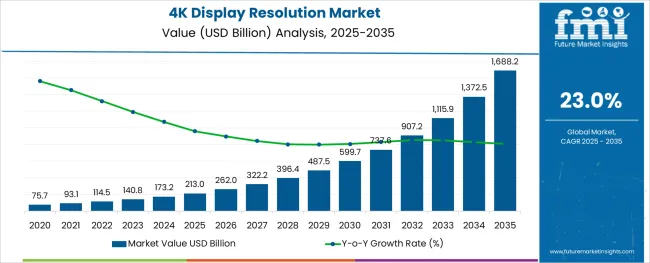
The 4K display resolution market is gaining significant traction as demand intensifies for ultra-high-definition visuals across industries that prioritize detail-rich imaging and immersive experiences. Continuous advancements in display technologies, combined with growing affordability of 4K-capable devices, are driving widespread adoption across both commercial and professional applications.
Industries such as surveillance, broadcasting, and defense have been early adopters due to the clarity and depth offered by 4K imaging. The integration of AI and real-time processing in 4K systems is also enhancing operational decision-making, especially in critical environments.
In addition, consumer electronics, gaming, and content creation segments are increasingly shifting toward 4K standards to meet rising expectations for visual quality. The future outlook remains strong, with accelerated investments in next-gen display infrastructure and growing availability of 4K content fueling continued expansion of this market.
The market is segmented by Vertical, Product Type, and Resolutions and region. By Vertical, the market is divided into Aerospace & Defence, Consumer Electronics, Retail & Advertisement, Media & Entertainment, and Business & Education. In terms of Product Type, the market is classified into Cameras, Digital Cameras, Camcorders, Projectors, Smartphones & Tablets, and Monitors & Smart TVs.
Based on Resolutions, the market is segmented into 3840 X 2160, 3996 X 2160, 4096 X 2160, 5120 X 2160, and 5120 X 3200. Regionally, the market is classified into North America, Latin America, Western Europe, Eastern Europe, Balkan & Baltic Countries, Russia & Belarus, Central Asia, East Asia, South Asia & Pacific, and the Middle East & Africa.
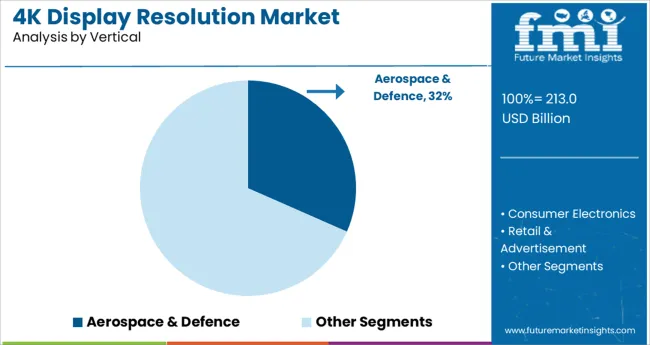
Within the vertical segment, aerospace and defence is expected to contribute 31.60 percent of total market revenue by 2025, establishing it as the leading industry vertical. This position is reinforced by the sector’s need for advanced imaging in simulation, surveillance, mission control, and situational awareness applications.
High-fidelity resolution is critical for enhancing precision and responsiveness in real-time operations, especially in aviation training and military monitoring environments. Adoption has been further supported by increasing investments in next-generation command systems that rely heavily on ultra-high-definition displays for data interpretation and threat analysis.
As operational reliability and image clarity remain non-negotiable, the 4K format has become indispensable in meeting the rigorous requirements of aerospace and defence missions.
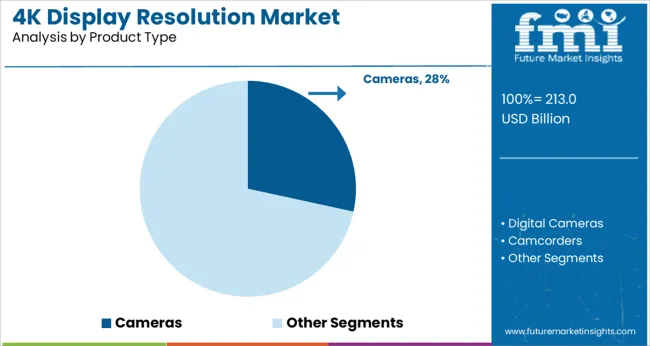
In the product type category, cameras are projected to hold a 28.40 percent revenue share in 2025, emerging as the dominant sub-segment. This trend is underpinned by the growing integration of 4K-enabled sensors in professional imaging devices, particularly within sectors such as broadcasting, security, and content production.
The demand for detailed video output and real-time analytics has accelerated the shift toward 4K cameras that offer enhanced pixel density, dynamic range, and color depth. Moreover, these cameras support a range of operational needs including aerial reconnaissance, studio-grade filming, and intelligent surveillance.
As organizations increasingly rely on visual data to drive insights and security protocols, the adoption of 4K cameras has become a strategic priority across multiple industries, contributing to their market leadership.
The global market for 4K display resolution is gaining momentum, owing to the highly defined pixel quality of 4K display monitors. There is a mounting demand for TVs and computer displays having 4K resolution technology. The growth of the 4K display resolution market globally exhibits the changing consumer preferences with respect to display monitors. The high costs are not halting the hype generated around by owning a TV with 4K display resolution.
The global 4K display resolution market has expanded to territories where a television set is still being considered as a luxury. The advancements in display resolution technologies have helped the realisation of farfetched concepts, such as a 4K or an 8K TV. The highly defined resolution of 4000 pixels serves as its basic quality, which is also driving the demand for 4K displays in the global market.
Consumers fed up with the traditional TV sets as well as the prominently existing LEDs and LCDs are opting for new products that enhance their visual experience.
The 4K display resolution market forecast for the period 2020 to 2025 is likely to be exceptionally promising. Trends encircling the global market for 4K display resolution are redefining the market dynamics for a resolute growth. Key trends influencing market growth include,
One of the most appealing feature of 4K display resolution, where the consumer can view the very minute details of a motion picture. Unlike LEDs or LCDs, 4K TVs are efficient in providing blur-free images at all times.
The 4K resolution technology is not restricted as an advancement in display technology. It is also incorporated in cameras that click photos and capture videos in high definition.
Availability of smartphones, tablets, portable gaming devices and TVs and any similar display devices are growing opportunities for the applicability of 4K display resolution technology.
Personal and public entertainment arent the only verticals driving demand for 4K display monitors. Such monitors are being significantly utilised by industrial verticals such product design, consumer electronics, advertisement, aerospace and defence technology, among others.
Growing number of tech enthusiasts is catalysing the growth of the 4K display resolution market.
Tech-savvy and entertainment-craving consumers are preferring to buy 4K display TVs as the ultimate television experience. Additional services such as smart TV and interactive applications are generating hype among consumers.
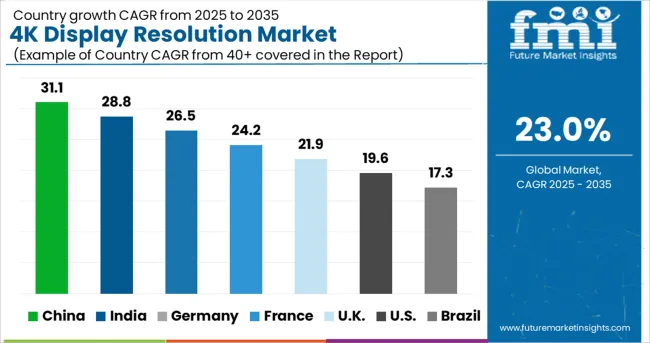
The global market for 4K display resolution is likely to be dominated by North America, considering the consumer preferences and the higher per capita income in the USA and Canada. Asia Pacific and Europe are key regions favouring the growth of the global 4K display resolution market. There is a need for expansion of the 4K display resolution market in the Middle East, Africa, and Japan.
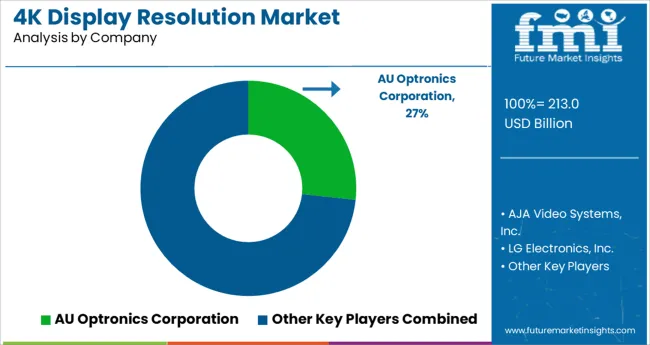
With an estimated consumer base of over 370 million households, the key companies leading the markets growth include AU Optronics Corporation, AJA Video Systems, Inc., LG Electronics, Inc., Panasonic Corporation, EIZO Corporation, Canon, Inc., Samsung Electronics Co. Ltd., Sharp Corporation, Sony Corporation, Planar Systems, Inc., and Red Digital Cinema Camera Company, among others.
This research report presents a comprehensive assessment of the 4K display resolution market and contains thoughtful insights, facts, historical data and statistically-supported and industry-validated market data and projections with a suitable set of assumptions and methodology.
It provides analysis and information by categories such as market segments, regions, product types and distribution channels.
The report is a compilation of first-hand information, qualitative and quantitative assessment by industry analysts, inputs from industry experts and industry participants across the value chain.
The report provides in-depth analysis of parent market trends, macro-economic indicators and governing factors along with market attractiveness as per segments. The report also maps the qualitative impact of various market factors on market segments and geographies.
The global 4K display resolution market is segmented on the basis of the verticals, the product type, resolutions and regions.
The global 4k display resolution market is estimated to be valued at USD 213.0 billion in 2025.
It is projected to reach USD 1,688.2 billion by 2035.
The market is expected to grow at a 23.0% CAGR between 2025 and 2035.
The key product types are aerospace & defence, consumer electronics, retail & advertisement, media & entertainment and business & education.
cameras segment is expected to dominate with a 28.4% industry share in 2025.






Full Research Suite comprises of:
Market outlook & trends analysis
Interviews & case studies
Strategic recommendations
Vendor profiles & capabilities analysis
5-year forecasts
8 regions and 60+ country-level data splits
Market segment data splits
12 months of continuous data updates
DELIVERED AS:
PDF EXCEL ONLINE
4K Technology Market Size and Share Forecast Outlook 2025 to 2035
4K Satellite Broadcasting Market Size and Share Forecast Outlook 2025 to 2035
4K VR Displays Market Size and Share Forecast Outlook 2025 to 2035
Ultra-High Definition (UHD) Panel (4K) Market Size and Share Forecast Outlook 2025 to 2035
Display Material Market Size and Share Forecast Outlook 2025 to 2035
Display Packaging Market Size and Share Forecast Outlook 2025 to 2035
Display Panel Market Size and Share Forecast Outlook 2025 to 2035
Display Pallets Market Size and Share Forecast Outlook 2025 to 2035
Display Controllers Market by Type, Application, and Region-Forecast through 2035
Display Drivers Market Growth – Size, Demand & Forecast 2025 to 2035
Displays Market Insights – Growth, Demand & Forecast 2025 to 2035
Market Share Distribution Among Display Pallet Manufacturers
Display Paper Box Market
Display Cabinets Market
3D Display Market Size and Share Forecast Outlook 2025 to 2035
3D Display Module Market
LED Displays, Lighting and Fixtures Market Size and Share Forecast Outlook 2025 to 2035
OLED Display Market Size and Share Forecast Outlook 2025 to 2035
Microdisplay Market Size and Share Forecast Outlook 2025 to 2035
IGZO Display Market Size and Share Forecast Outlook 2025 to 2035

Thank you!
You will receive an email from our Business Development Manager. Please be sure to check your SPAM/JUNK folder too.
Chat With
MaRIA